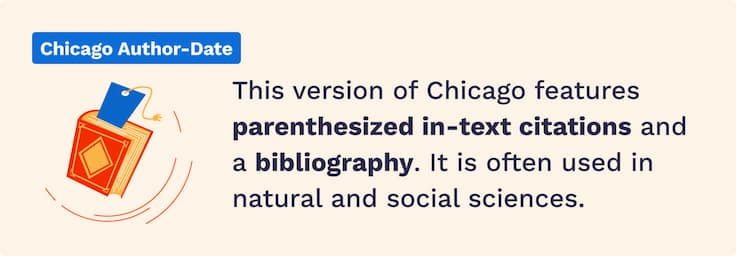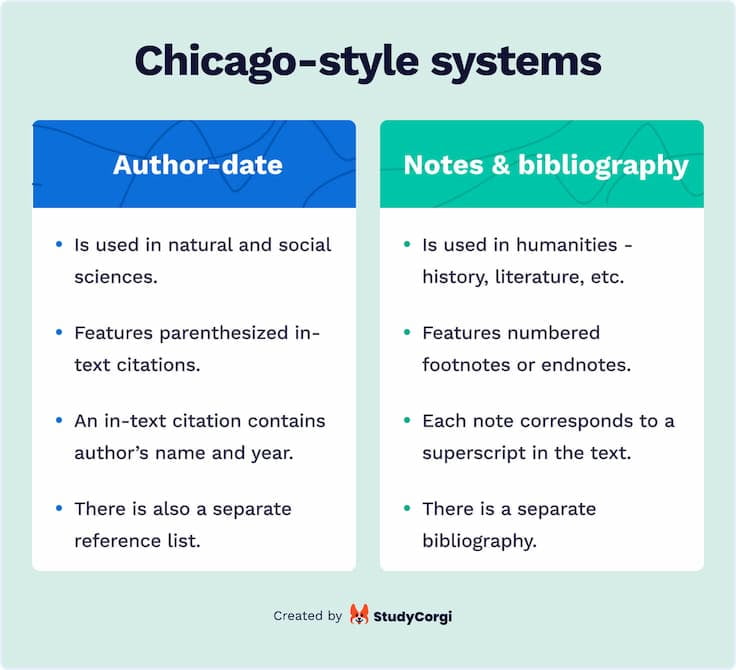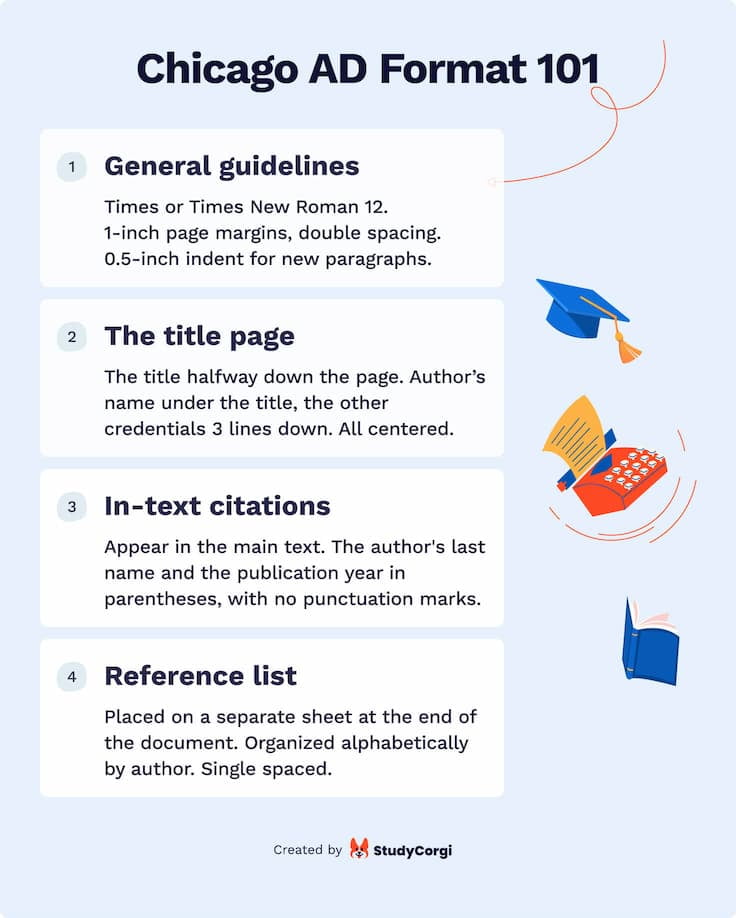🛠️ Citation Machine Chicago Author-Date Style - How to Use It?
Take the 4 steps below to use the tool:
- Choose the type of source you wish to cite. It can be a website, a book, an article, a chapter in edited books, or a social media post.
- Provide the necessary information in the search bar. Users can paste URLs, titles, DOI, or ISBN information.
- Add the information manually if there are any difficulties with your search.
- Click “Cite” once you’re done.
Note that you can save bibliographical lists and name them. For example, “Frankenstein essay” or “Linguistics project.” Additionally, you can copy references and enable the “in-text citation” option. Users may even use the quoting machine to download bibliographies in Word format.
🔥 Chicago Author-Date Citation Maker Benefits
There are 4 key benefits of using our citation machine:
| 100% Intuitive | Our tool knows what you want from a citation. All users have to do is select a style and add the necessary information. You can use prompts to guide you through this process if it's your first time using our platform. |
| 100% Accurate | We’ve spent considerable time and effort developing and fine-tuning this tool. It generates quotes that strictly follow the current versions of modern quotation styles. |
| 100% Quick | You can quickly search for citations by title, DOI, and ISBN. They can be used to find suitable sources automatically. You can also enter requests manually if you fail to find the necessary sources based on their characteristics. |
| 100% Ad-free | Our platform is entirely free of intrusive banners and video ads. You won’t have to pay to disable the ads. |
📖 Chicago AD Format 101
The Chicago Manual of Style is a famous writing guide for students, researchers, copywriters, proofreaders, and professional editors.

Its history began in 1891 when the University of Chicago Press was opened.
The first edition of the Chicago Manual was presented in 1906 and immediately became an influential writing guideline for the academic community and publishing industry.
Nowadays, we use the 17th edition of The Chicago Manual of Style, which contains more than a thousand pages with grammar, punctuation, and formatting rules.
Many high school and university students follow the Chicago style when writing research papers, articles, and theses. It is mainly used in political, social, and natural sciences.
Overall, The Chicago Manual of Style provides guidelines for 2 different formats of citations:
- Notes and bibliography,
- Author-date.
This article will discuss the author-date style, which is the preferred option for political, social, and natural sciences.
Learning how to format your citation correctly is crucial to avoid plagiarism when quoting or paraphrasing a passage from a book or a scholarly article in your writing. Continue reading to learn more about the Chicago AD format, and check out our free Chicago author-date citation maker.
Chicago AD vs. Chicago NB
There are two methods of citing sources within the Chicago style: the notes and bibliography method and the author-date method.
So, what's the difference between them?

Chicago NB
- All the citations appear in footnotes or endnotes.
- While footnotes are presented at the bottom of the page, endnotes have their own section at the end of the whole paper.
- A superscript number leading to a note is placed at the end of the sentence.
- A reference list/bibliography collects all the cited sources and provides complete information.
Chicago AD
- In-text citations consist of the author's name, the year of publication, and a page range.
- Each citation corresponds to an entry in the reference list at the end of the writing.
- The reference list provides an overview of all the sources used in writing.
💬 Chicago AD Citation Format
The below sections explain how Chicago author-date in-text citations and references should be formatted.

General Guidelines
If you decide to write a paper following the Chicago style, consider these requirements:
- Use a single classic font for the main text, such as Times New Roman or Arial, 12 pt.
- Apply one-inch/2.5cm margins at the top, bottom, and on both sides of each page.
- Double-space the main text. For the reference list, add a blank line before and after each entry.
- Double-space the main text.
- Number all the pages, except the title page, in the upper right-hand corner.
- Indent the beginning of each new paragraph one-half inch.
Chicago Title Page
A title page isn't necessary for some writings in Chicago style. However, it attracts readers' attention and makes the work look academic.
Check with your instructor if you need to include the title page, and consider using our Chicago title page generator.
The Chicago-style title page should include the following:
- The title of your paper and possibly the subtitle. They should be centered and placed approximately one-third of the way down the page.
- Your name also should be centered below the title by several lines.
- The course title, instructor's name, and date are centered below your name. Note that all these elements appear on separate lines.
Avoid any kind of text stylization for your title page. Use the same font you've chosen for the main text, Times New Roman or Arial, 12pt.
Generating Chicago AD In-Text Citations
The first element of Chicago's author-date style is in-text citations.
In-text citations appear in the main text whenever you quote, reword, or comment on a source.
After the text fragment or a sentence the citation refers to, you should mention the author's last name and the publication year in parentheses, with no punctuation marks.
Here's an example:
(Miller 2020)
However, if you refer to a specific part of the writing, you should add a page number or range. They appear after the comma, and the page range is separated by an en dash, like that:
(Miller 2020, 21–22)
If you make several references to different sources in a sentence, you can organize the citations on one set of parentheses by separating them with a semicolon.
(Miller 2020; Johnson 2018)
Chicago AD In-Text Citations Examples
Here are some more examples of Chicago in-text citations.
Multiple Authors/Editors/Translators/Compilers in In-text Citations
If there are 2 or 3 authors, put their names in the same order as they appear in the source.
(Miller and Johnson 2020)
(Miller, Johnson, and Smith 2020)
For sources with 4 or more authors, only mention the first author's name followed by "et al."
(Miller et al. 2020)
Citing Various Sources with the Same Author and Year
Using another identifier is important if you choose various sources from the same author published in the same year for your writing.
To help readers distinguish between the sources in the text, you can add a letter after the year: a, b, c, etc.
(Miller 2020a)
(Miller 2020b)
Remember that each in-text citation should correspond with an entry from the reference list, which will contain more details on the source.
Citing Sources with Missing Information
Sometimes you might lack some information on the source required for a citation.
If you cite a source with the publication date missing, write "n.d." instead of the year in your in-text citation.
(Miller n.d.)
Sometimes it happens that a source has no author. In this case, you can either mention an organization that published the source or use the shortened version of the source title.
(University of London 2020)
(Writing Styles 2020)
Finally, if you refer to an anonymous source in your writing, simply use it instead of a name.
(Anonymous 2020)
Generating Chicago AD References
A reference list is another vital part of the Chicago AD style that collects all the references cited in your writing.
The purpose of a reference list is to give credit to all the authors you've consulted for their ideas and to allow readers to find sources they're interested in.
Chicago AD Reference List
Consider these general guidelines for reference list formatting.
- The reference list appears on a new page.
- The title "Reference list" should be centered.
- Use a hanging indent for your references. This means that hanging the first line of each entry starts at the border, while each subsequent line is indented 0.5 inches (1.27 cm).
- Double-space between reference list entries.
- Mention reference list entries in alphabetical order by author's last name.
- Avoid any text stylization. Instead, use the font you chose for the main part, Times New Roman or Arial, 12 pt.
Chicago AD Reference List Examples
You can use various sources as references for your writing, including books, scholarly articles, e-books, interviews, and even websites. Here's how to correctly format your reference list entries based on a source type.
Books
To format a book entry correctly, you need to provide the necessary bibliography details: author's last name and first name, year of publication, title, city, and publisher.
Owen, Stephen. 1990. What is world poetry? New York: The New Republic.
Book Chapters
Remember to add the page range in your reference list for book chapters.
Maxwell, Glyn. 2012. "Form." In On Poetry, 89–101. London: Bloomsbury Publishing.
E-books
Include a URL or DOI in the reference list entry when citing a book you consulted online. Write down a chapter title if an e-book has no fixed page numbers.
Wainwright, Jeffrey. Poetry: The Basics. Routledge EBooks. Informa, 2015. https://doi.org/10.4324/9781315742137.
Journal Articles
Citing articles works similarly to book chapters; you must add page ranges to your reference list. If you consulted an article online, mentioning the URL or DOI is necessary.
Wakeman, Brian E. 2015. "Poetry as Research and as Therapy." Transformation 32 (1): 50–68. https://www.jstor.org/stable/90010960.
Interviews
To cite the interview correctly, mention the interviewer or the organization that conducted it.
Steed, Edward. "Edward Steed's Curiosities." Interview by Françoise Mouly. New Yorker, February 20, 2023. https://www.newyorker.com/culture/cover-story/cover-story-2023-02-27.
Website Content
When citing the content shared through social media, mention the organization of the person who produced it and the URL readers can access.
TED. "Why People Love Watching Sports | Kate Fagan | TED," December 16, 2022. https://www.youtube.com/watch?v=3x3X6HELtog.
🎁 Chicago AD 17th Edition - What's New about It?
The newest 17th edition of the Chicago style manual introduced several significant changes concerning the in-text citation and reference list. Consider them:
- For the reference list, you can now mention DOI (Digital Object Identifier) for online sources besides the URL.
- If you cite an online book, journal, or magazine that doesn't have a printed version, don't italicize its title.
- To be more precise, in the reference list, you can now repeat the year in two places within one entry.
Clarifying the year is especially important for newspaper and journal articles.
For example:
Fountain, Henry, and Mette Lampcov. 2023. "The Salton Sea, an Accident of History, Faces a New Water Crisis." The New York Times, February 25, 2023. https://www.nytimes.com/2023/02/25/climate/salton-sea-colorado-river-drought-crisis.html.
In case you struggle with catching up with all the Chicago-style updates, don't worry. You can always use our free citation machine Chicago author-date, to ensure your references fit all the requirements.
Thank you for reading this Chicago author-date format guideline! Note that we’ve also prepared similar tools and instructions for APA, Harvard, Chicago NB, MLA, and Turabian.
❓ Chicago AD Citation Machine FAQ
❓ How cite Chicago author-date?
Chicago author-date format includes in-text citations and a reference list. In-text citations appear in parentheses after the sentence that refers to a specific source. Then all the in-text citations are collected in a reference list at the end of the paper. The purpose of the reference list is to provide the full bibliography information on each source.
❓ How do author-date Chicago references?
Chicago author-date format has two main elements: in-text citations and a reference list. A reference list collects all the sources you referred to in your writing to help readers navigate easily. For reference list entries, you can use our Chicago author-date citation maker or the template: Author last name, first name. Year. Title of Book. Place of publication: publisher.
❓ What is a Chicago-style citation example?
In the author-date system, citations appear directly in the text instead of using notes. After the sentence which contains a quote or paraphrased text, you should put parentheses with the author's last name and publication date. If you refer to a specific fragment from the source, you can also add the page number(s).
❓ Who uses Chicago-style citations?
The Chicago Manual of Style contains guidelines on correctly structuring and formatting your research paper, article, thesis, or dissertation. Chicago author-date format, which consists of in-text citations and a reference list, helps avoid plagiarism and adds academic value to your writing. It's prevalent in the fields of natural and physical sciences.